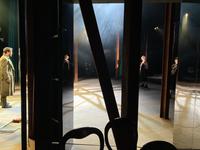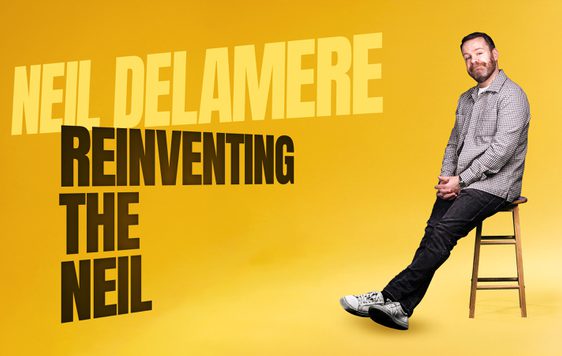News Story
Stop what you are doing! The final design meeting for Macbeth (an undoing) has happened and I was lucky enough to be invited in to see what the set and costume will look like for the production. If you’re hoping for blood, the supernatural and a visually stunning set... you won’t be disappointed.
What is the meeting – what is discussed
The final design meeting brings together members, from a lot of different departments, that work together to put on a main stage performance. This is so that they can see the designs and ask lots of very technical questions of it to make sure that it is going to work.
Questions such as
- Do we need a real bird?
- How will we get blood to come out of there?
- Where does that massive structure go when it’s not on stage?
- How many of that costume needs to be made?
First to present to the group was the Set Designer. Armed with a black model box set, lamp and floor plans, we were transported into the world of Macbeth (an undoing).
There are lots of things that a set designer needs to consider when creating a world on the stage, it isn’t all about the visual design, technical design elements also need to be thought about. From the needs of the writer, director and actors to the space the set will be in and the logistics of the stage. Let’s break this down the needs of the space/theatre.
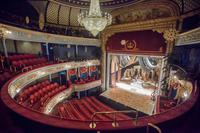
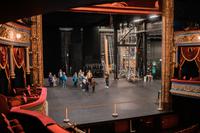
Needs of the space when designing a set
The Lyceum stage is quite a unique space as it remains the same as it was when the theatre opened in 1883. One of the challenges is that the stage is raked, which means it is on a slope towards the audience. This helps with sight lines for both the audience and the actors but comes with its own difficulties when planning and making a set. The stage team can de-rake the stage and make it flat, but a lot of designers choose to keep the slope, so tables, chairs and big bits of set are de-raked to make them look right. To do this one side of a table has to be lower than the other to table legs are cut down and chairs legs made wonky. If we didn’t do this, a character would look slanted if they were to sit down and things would slide off tables.
The raked stage also means the designer must consider props, and in this productions case, blood, and making sure that these things don’t roll onto the audience if they are on the floor of the stage. To prevent the blood dripping onto the front stalls' toes in Duchess of Malfi the stage management installed a gutter system at the front of the stage to collect all the blood.
Other things that need to be considered when designing for The Lyceum are the wings. A designer needs to think about whether they want the wings concealed or whether they become part of the world that is being created. We have a large wing on stage right and a smaller one on stage left. These can be hidden from the audience by using flats to mask offstage. Alternatively, some designers want the actors to be seen walking around, so they decide not to mask the wings. In Zinnie’s last production; A Scent of Roses, the sides of the stage were masked...but will Macbeth (an undoing) be the same?
I didn’t know if you knew but our stage can also be extended, which is also something that the designer needs to consider. If you have had a tour of our theatre, you will have heard about the orchestra pit that is at the front of our stage, should we want to use it. But also, we can extend the stage so that the actors have more space to work with and the performance can break free of the proscenium arch and feel more connected to the audience. It also stops actors from feeling like they are going to fall off the stage due to the rake and the opposite rake of the stalls. It can feel like quite a drop when you are standing on the edge.
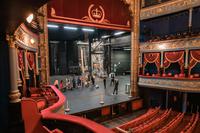
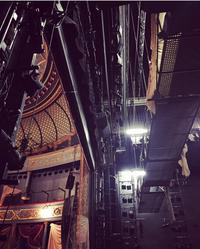
As well as design elements for the set and making things look visually interesting, technical aspects need to be considered when thinking about how set is moved (is it moved by the stage team or the actors on stage) and making it safe for actors and stage managers, as well as flying set in and the logistics of that happening. For flying set in, our stage, essentially, has another stage above it where we can store the set until it’s needed for a scene. This is also great for grand reveals!
Next up to present was the costume designer. Gorgeous designs in hand, they talked us through the many characters, costume changes and hidden secrets (spoiler!) as well as their overall vision for the performance.
How to evaluate costume designs
Designing costumes also comes with its own challenges. As a designer it is your job to create something that reflects the characters and world that the writer/director has created as well as working with the in-house costume department to make sure that it is something they can make and is achievable in the time frame (they often have a strict time limit on costume creation).
Examples of questions that a designer needs to consider are things such as:
- Is it easy to clean blood off that fabric?
- Does the costume reflect where the character is in the performance?
- How many of that costume needs making and is it the most detailed one?
- Does it need pockets to conceal things?
What other questions do you think need to be asked when designing costumes?
A costume can say a lot about a character, it can highlight and show a character's importance, key moments in the play can be reflected in what they are wearing, and it is all in the detail.
Another thing the costume designer considers is whether the theatre already has costumes in its store that can be pulled and adapted for the show. It is important to The Lyceum that we are re-using as much as possible rather than buying new material and adding to our wardrobe department. This can help with creativity but can also hinder it.
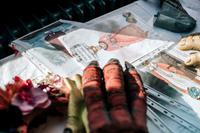
Tips for presenting to a group
Come prepared. Visual aids are your best friend, where words fail images speak. It’s important to think about how different people absorb information. Can you bring drawings/mood boards/storyboards to help with talking about your concept.
For stage designers – pop a lamp on top of your black model box to show where light will be coming from as it can completely change how a design is viewed. Light sources can help convey the atmosphere and environment that you are trying to show.
Be open to people saying no to your ideas. You are designing for someone else and working in a pre-made space and you must fit within those guidelines. Be confident with your idea but also understand that things might have to change and that isn’t a critique of you or what you have designed.
Bring floor plans and different ways of looking at your work. Be technical about your designs. Sizes of props and set pieces, sizes of accessories on costume, specific colours and patterns. Are your designs symbolic so need to be specific? A colour, a texture, language.
Ask for feedback!
Set and costume designers' ideas come from everywhere and anywhere. If you are interested in becoming a designer, here are our tips for finding your inspiration.
- Take photos of everything that interests you
- Mood boards are your best friend; they can help guide your ideas
- Explore different eras and how you would design them. What makes the 20s different from the 90s if you were to create a set/environment
- Start with a practical prop, like a set of stairs and build around it
- Create someone’s front room, based on people you observe in the world around you – this can be an interesting way to think about someone's own possessions and how they would fit into the world they are in
- Consider how you would layer the space. Worlds aren’t flat 2D spaces, do you have steps or platforms, are there things hanging above your actors
- Designing for costume is the same approach but instead of a world you are looking at people and characters
Practice is key, the more you design and make the better you will become. Explore designing worlds that you imagine up, design for a play you have seen or one you have read. Work with designing for different spaces and stages. You don’t have to be employed as a designer to build a portfolio, grab some scissors, glue and pens and start designing. We can’t wait to see the next generation of designers at The Lyceum!
